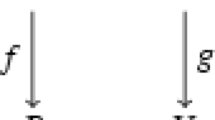Abstract
In this paper, we introduce relative left Bongartz completions for a given basic \(\tau \)-rigid pair (U, Q) in \(\textsf {mod} \,A\). They give a family of basic \(\tau \)-tilting pairs containing (U, Q) as a direct summand. More precisely, to each basic \(\tau \)-tilting pair (M, P) with \(\textsf {Fac} \,M\subseteq ^{\bot }_{}{(\tau U)}\cap Q^\bot \), we prove that \(\textsf {Fac} \,U*({\mathcal {W}}\cap \textsf {Fac} \,M)\) is a functorially finite torsion class in \(\textsf {mod} \,A\) such that \(\textsf {Fac} \,U\subseteq \textsf {Fac} \,U*({\mathcal {W}}\cap \textsf {Fac} \,M) \subseteq ^{\bot }_{}{(\tau U)}\cap Q^\bot \), where \(\mathcal W:=U^\bot \cap ^{\bot }_{}({\tau U})\cap Q^\bot \) is the wide subcategory associated to (U, Q). Thus \(\textsf {Fac} \,U*({\mathcal {W}}\cap \textsf {Fac} \,M)\) corresponds to a basic \(\tau \)-tilting pair \((M^-,P^-)\) containing (U, Q) as a direct summand. We call \((M^-,P^-)\) the left Bongartz completion (or Bongartz co-completion) of (U, Q) with respect to (M, P). Notice that \((M^-,P^-)\) coincides with the usual Bongartz co-completion of (U, Q) in \(\tau \)-tilting theory if \((M,P)=(0,A)\). We prove that relative left Bongartz completions have nice compatibility with mutations. Using this compatibility we are able to study the existence of maximal green sequences under \(\tau \)-tilting reduction. We also explain our construction and some of the results in the setting of silting theory.
Similar content being viewed by others
References
Adachi, T., Iyama, O., Reiten, I.: \(\tau \)-tilting theory. Compos. Math. 150(3), 415–452 (2014)
Aihara, K., Iyama, O.: Silting mutation in triangulated categories. J. Lond. Math. Soc. 85(3), 633–668 (2012)
Asai, S.: Semibricks. Int. Math. Res. Notes 2020(16), 4993–5054 (2018)
Auslander, M., Smalø, S.O.: Almost split sequences in subcategories. J. Algebra 69(2), 426–454 (1981)
Barnard, E., Carroll, A., Zhu, S.: Minimal inclusions of torsion classes. Algebr. Comb. 2(5), 879–901 (2019)
Bongartz, K.: Tilted algebras. In: Proceedings of the ICRA III Lecture Notes in Mathematics, vol. 903. Springer, Berlin (1980)
Brüstle, T., Smith, D., Treffinger, H.: Wall and chamber structure for finite-dimensional algebras. Adv. Math. 354, 106746 (2019)
Cao, P.: G-systems. Adv. Math. 377, 107500 (2021)
Cao, P., Li, F.: The enough g-pairs property and denominator vectors of cluster algebras. Math. Ann. 377, 1547–1572 (2020)
Demonet, L., Iyama, O., Jasso, G.: \(\tau \)-tilting finite algebras, bricks, and g-vectors. Int. Math. Res. Notes 2019(3), 852–892 (2017)
Demonet, L., Iyama, O., Reading, N., Reiten, I., Thomas, H.: Lattice theory of torsion classes: Beyond \(\tau \)-tilting theory. Trans. Am. Math. Soc. Ser. B 10(18), 542–612 (2023)
Derksen, H., Weyman, J., Zelevinsky, A.: Quivers with potentials and their representations I: Mutations. Sel. Math. New Ser. 14, 59–119 (2008)
Fomin, S., Zelevinsky, A.: Cluster algebras. In: Notes for the CDM-03 Conference, Current Developments in Mathematics, pp. 1–34 (2003)
Fomin, S., Zelevinsky, A.: Cluster algebras I: Foundations. J. Am. Math. Soc. 15, 497–529 (2002)
Fomin, S., Zelevinsky, A.: Cluster algebras IV: Coefficients. Compos. Math. 143(1), 112–164 (2007)
Fu, C., Geng, S., Liu, P.: Exchange Graphs of Cluster Algebras have the Non-Leaving-Face Property. Preprint arXiv:2207.05555 (2022)
Iyama, O., Nakaoka, H., Palu, Y.: Auslander–Reiten Theory in Extriangulated Categories. Preprint arXiv:1805.03776 (2018)
Iyama, O., Yang, D.: Silting reduction and Calabi–Yau reduction of triangulated categories. Trans. Am. Math. Soc. 370, 7861–7898 (2018)
Iyama, O., Yoshino, Y.: Mutation in triangulated categories and rigid Cohen–Macaulay modules. Invent. Math. 172, 117–168 (2008)
Iyama, O., Jørgensen, P., Yang, D.: Intermediate co-t-structures, two-term silting objects, \(\tau \)-tilting modules, and torsion classes. Algebra Number Theory 8, 2413–2431 (2014)
Jasso, G.: Reduction of \(\tau \)-tilting modules and torsion pairs. Int. Math. Res. Notes 2015(16), 7190–7237 (2014)
Keller, B., Demonet, L.: A survey on maximal green sequences. Contemp. Math. 758, 267–286 (2020)
Muller, G.: The existence of a maximal green sequence is not invariant under quiver mutation. Electron. J. Combin. 23(2)(paper 2.47), 1–23 (2016)
Nakaoka, H., Palu, Y.: Extriangulated categories, Hovey twin cotorsion pairs and model structures. Cah. Topol. Géom. Différ. Catég. 60(2), 117–193 (2019)
Yurikusa, T.: Wide subcategories are semistable. Doc. Math. 23, 35–47 (2018)
Acknowledgements
P. Cao is very grateful to Professor David Kazhdan for providing him with a very comfortable working environment and to Yafit-Laetitia Sarfati for her much help in campus life. P. Cao is supported by the European Research Council Grant No. 669655, the National Natural Science Foundation of China Grant No. 12071422, and the Guangdong Basic and Applied Basic Research Foundation Grant No. 2021A1515012035. H. Zhang is supported by Natural Science Research Start-up Foundation of Recruiting Talents of Nanjing University of Posts and Telecommunications Grant No. NY222092.
Author information
Authors and Affiliations
Corresponding author
Additional information
Dedicated to Professor Bernhard Keller on the occasion of his 60th birthday.
Publisher's Note
Springer Nature remains neutral with regard to jurisdictional claims in published maps and institutional affiliations.
Rights and permissions
Springer Nature or its licensor (e.g. a society or other partner) holds exclusive rights to this article under a publishing agreement with the author(s) or other rightsholder(s); author self-archiving of the accepted manuscript version of this article is solely governed by the terms of such publishing agreement and applicable law.
About this article
Cite this article
Cao, P., Wang, Y. & Zhang, H. Relative left Bongartz completions and their compatibility with mutations. Math. Z. 305, 27 (2023). https://doi.org/10.1007/s00209-023-03357-9
Received:
Accepted:
Published:
DOI: https://doi.org/10.1007/s00209-023-03357-9



